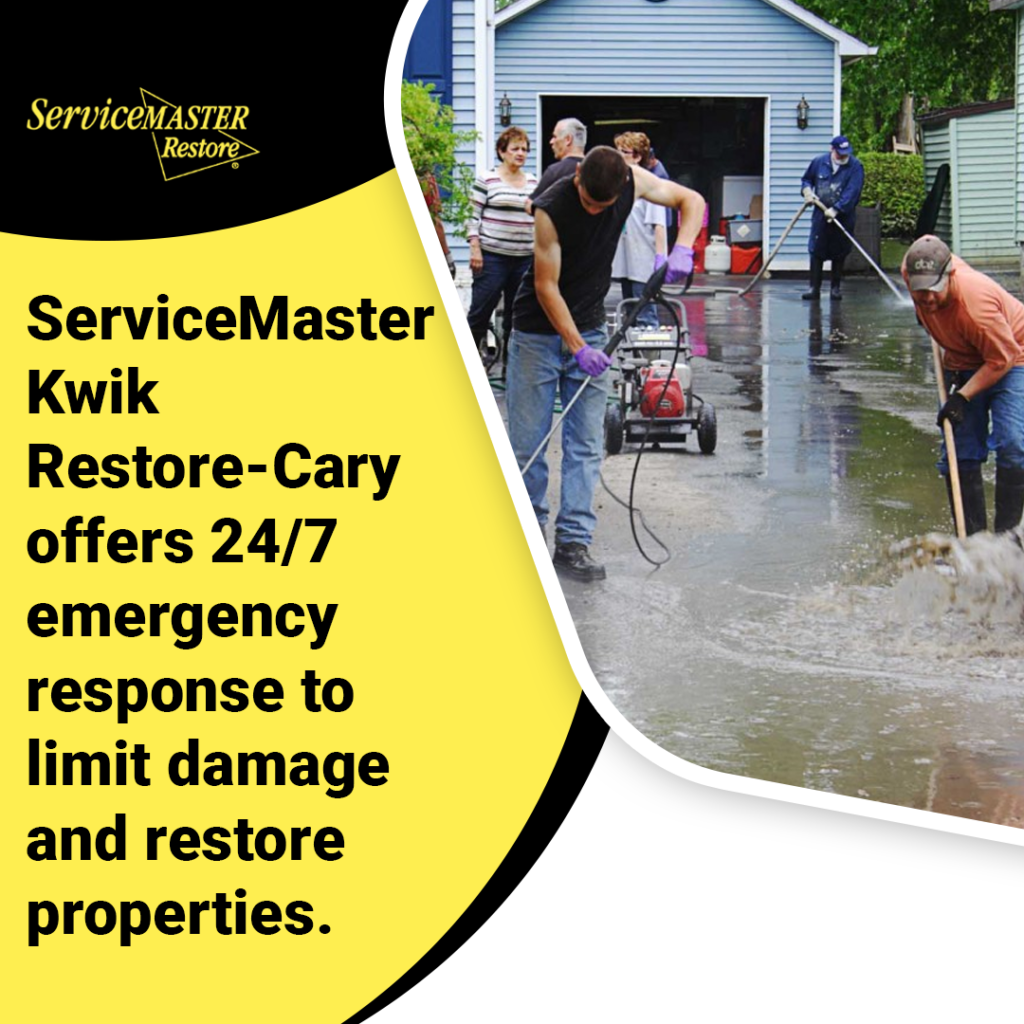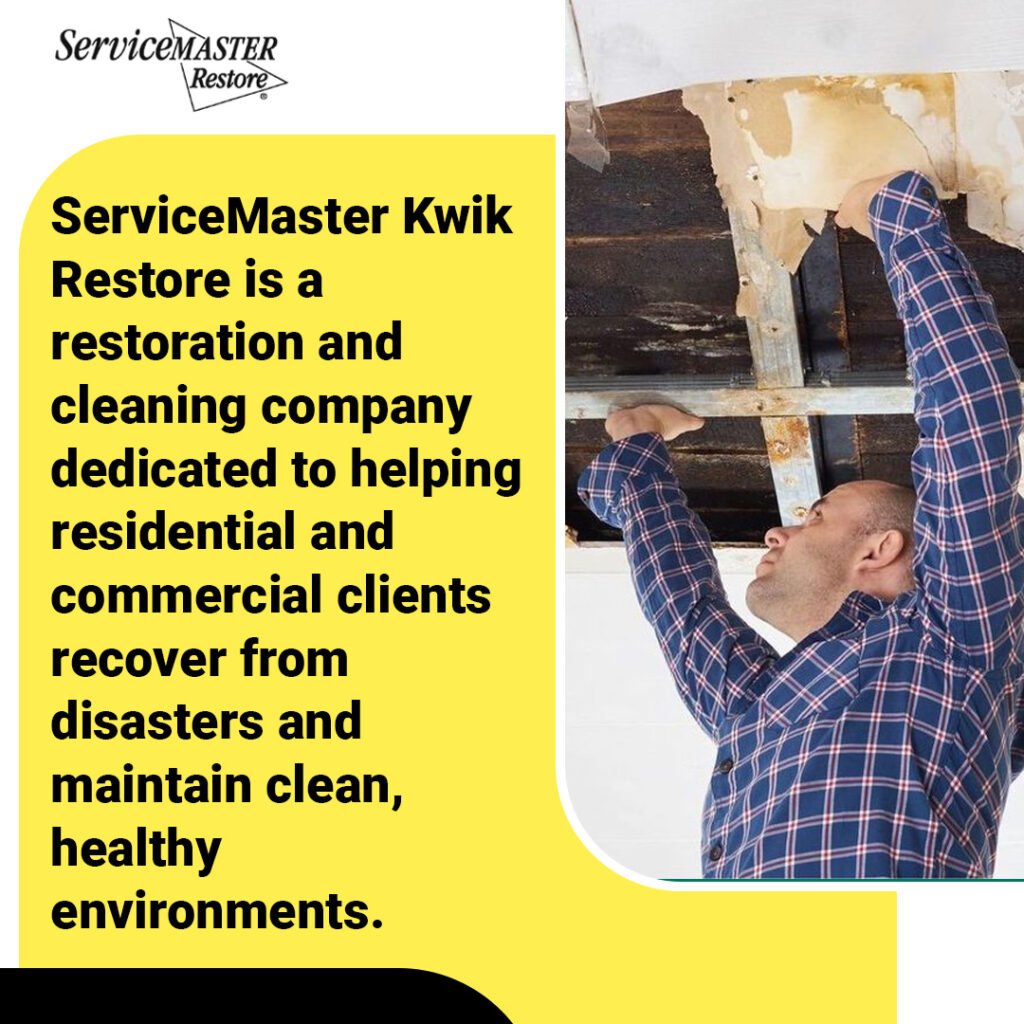Water damage can disrupt life without warning. In Trout Valley, homeowners and businesses face challenges from heavy rainfall, plumbing failures, and other unexpected events. When these incidents occur, quick action is vital to mitigate damage and restore property. Water damage restoration services provide the necessary help to address these situations. Professionals offer immediate water cleanup to remove standing water and begin the drying process. For areas affected by severe weather, flood restoration services address the specific problems caused by large-scale water intrusion. ServiceMaster Kwik Restore – Cary offers emergency water damage restoration to residents of Trout Valley, ensuring a prompt response when needed.
Considering Water Damage in Trout Valley
Water damage presents a serious threat to properties in Trout Valley, requiring a clear awareness of its causes and the importance of timely intervention. Local environmental factors and common household incidents contribute to the frequency and severity of these events. Addressing these issues effectively demands a systematic approach to mitigation and restoration.

Common Causes of Water Damage in Trout Valley
- Heavy Rainfall and Flooding: Trout Valley’s geographic location makes it susceptible to heavy rainfall, which can overwhelm drainage systems. This results in localized flooding, affecting basements and low-lying areas. The intense nature of these storms can cause rapid water accumulation, leading to significant property damage.
- Burst Pipes and Plumbing Leaks: Older plumbing systems, combined with temperature variations, lead to pipe bursts. Leaks from faulty connections or damaged pipes can go unnoticed for extended periods, causing substantial water damage to walls, floors, and ceilings. The gradual nature of these leaks creates a risk of hidden damage.
- Appliance Malfunctions: Washing machines, dishwashers, and water heaters are prone to malfunctions that release large volumes of water. Hose failures, seal deterioration, or internal component breakdowns contribute to these incidents. The immediate area around the appliance is affected, and water can spread rapidly to nearby rooms.
- Sewer Backups: Sewer line blockages or failures cause backups that introduce contaminated water into properties. This type of water damage presents a health hazard due to the presence of bacteria and pathogens. The cleanup process requires specialized equipment and procedures to guarantee proper sanitation.
The Urgency of Immediate Water Damage Cleanup
- Preventing Structural Damage: Water penetrates porous materials like drywall, wood, and insulation, causing them to weaken and deteriorate. Prolonged exposure leads to structural instability, requiring extensive repairs. Quick water removal and drying actions prevent this deterioration.
- Minimizing Mold Growth Risk: Mold thrives in damp environments. Within 24 to 48 hours of water exposure, mold growth begins. This poses a health risk and requires specialized remediation. Immediate drying actions reduce the likelihood of mold infestation.
- Safeguarding Health and Safety: Contaminated water, especially from sewer backups, contains harmful substances. Electrical hazards exist when water comes into contact with wiring.
Prompt water removal and thorough sanitization protect occupants from these dangers.
Extensive Water Damage Restoration Services
A methodical application of techniques is necessary for effective water damage restoration in order to restore a property to its pre-loss state. The process addresses immediate water removal, structural drying, sanitation, and necessary reconstruction. Each step requires specific techniques and equipment to mitigate damage and prevent further issues.
Emergency Water Extraction and Removal
- Utilizing Advanced Pumping Equipment: The initial response involves the removal of standing water using powerful pumps. These devices handle large volumes of water quickly. The selection of equipment depends on the extent and type of water present.
- Safe Water Disposal and Containment: Proper disposal of extracted water is vital. Contaminated water requires adherence to safety protocols. Containment procedures prevent the spread of water to unaffected areas.
Structural Drying and Dehumidification
- Implementing Industrial-Strength Dehumidifiers: After water removal, drying affected materials is essential. Industrial dehumidifiers reduce moisture levels in the air. This process prevents secondary damage, such as mold growth and warping.
- Monitoring Moisture Levels and Airflow: Regular monitoring of moisture levels ensures effective drying. Airflow is controlled to promote evaporation. This process requires precise measurements and adjustments.
Cleaning and Sanitization
- Disinfecting Affected Surfaces: Cleaning and disinfecting surfaces remove contaminants. This step is vital for health and safety. The use of appropriate cleaning agents prevents the spread of bacteria and fungi.
- Odor Removal and Deodorization: Water damage often leaves lingering odors. Deodorization techniques eliminate these smells. Specialized equipment and chemicals are used to neutralize odor-causing particles.
Restoration and Reconstruction
- Repairing Damaged Walls, Floors, and Ceilings: Damaged structural components require repair. This includes drywall, flooring, and ceiling repairs. The extent of damage determines the scope of repairs.
- Replacing Irreparable Materials: Some materials cannot be salvaged. These items must be replaced. Matching replacement materials to existing structures is important for aesthetic and structural integrity.
Flood Restoration Services: Specialized Solutions for Trout Valley
Trout Valley’s geographical characteristics present specific challenges for flood restoration services. The area’s proximity to rivers and susceptibility to heavy rainfall necessitates specialized approaches that account for the unique nature of flood damage. These services necessitate a targeted comprehension of the effects of river flooding and contaminated water.
Addressing Unique Flood Damage Challenges
- Handling Contaminated Floodwater: Floodwater often contains sewage, chemicals, and other hazardous materials. This contamination requires specialized handling during the flood restoration process. Professionals must adhere to strict safety protocols to prevent health risks. Effective decontamination procedures are essential to render affected areas safe for occupancy.
- Restoring Properties Affected by River Flooding: River flooding poses distinct problems due to prolonged exposure to water and the force of the flow. Properties near rivers experience increased saturation and potential structural damage. Specialized techniques are needed to mitigate these effects. This includes addressing soil erosion and structural weakening.
The Flood Restoration Process
- Initial Damage Analysis and Planning: The initial step in flood restoration services involves a thorough analysis of the damage. This includes evaluating the extent of water intrusion, identifying contaminated areas, and determining structural integrity. A detailed plan is then developed to guide the restoration process.
- Debris Removal and Cleanup: Floodwaters carry debris, including mud, silt, and other contaminants. Removal of this debris is a critical part of the flood restoration process. Specialized equipment is used to clear large volumes of debris. Proper disposal of contaminated materials is also vital.
- Drying and Restoration: After debris removal, complete drying is required. Industrial-grade dehumidifiers and air movers are used to eliminate moisture. This step prevents mold growth and further structural damage. Restoration includes repairs to damaged walls, floors, and other structural components. The goal is to return the property to its pre-flood condition.
Why Choose Professional Water Damage Restoration in Trout Valley?
Selecting a professional for water damage restoration in Trout Valley offers clear advantages. These services provide expertise, advanced tools, rapid response, and assistance with insurance claims, all of which are vital for effective property recovery.
Expertise and Experience
- Certified and Trained Technicians: Professionals possess certifications and training in water damage restoration. This training includes knowledge of industry best practices and safety standards. Technicians understand the complexities of water damage and apply correct procedures.
- Knowledge of Local Trout Valley Conditions: Local professionals know Trout Valley’s specific environmental conditions. This includes a grasp of local weather patterns and common sources of water damage. This local awareness enables a tailored approach to restoration.
Advanced Equipment and Technology
- Utilizing Most Modern Restoration Tools: Professionals use specialized equipment for water extraction, drying, and moisture detection. This equipment ascertains efficient removal of water and reduction of moisture levels. The use of this equipment prevents secondary damage.
- Accurate Moisture Detection and Monitoring: Moisture levels are monitored using specialized tools. This monitoring helps with proper drying and prevents mold growth. Accurate measurements provide data to guide the restoration process.
24/7 Emergency Response
- Rapid Arrival and Immediate Action: Professional services provide emergency reactions around the clock. This assures prompt access to the property and prompt damage mitigation measures. Rapid reaction times reduce the amount of harm.
- Minimizing Further Damage and Downtime: Immediate action reduces the risk of further damage. This includes structural damage and mold growth. Reduced downtime allows for a faster return to normal activities.
Working with Insurance Companies
- Streamlining the Claims Process: Professionals assist with the insurance claims process. They provide documentation and communicate with insurance companies. This assistance simplifies the claims process.
- Providing Detailed Documentation: Professionals provide detailed documentation of the damage and restoration process. This documentation is required for insurance claims. Accurate and complete records support the claims process.
Preventing Future Water Damage in Your Trout Valley Property
Proactive measures reduce the risk of future water damage in Trout Valley properties. Regular maintenance, protective installations, and a clear idea of insurance coverage provide a strong defense against potential water-related incidents. ServiceMaster Kwik Restore – Cary recommends these practices to safeguard properties.
Regular Maintenance and Inspections
- Checking Plumbing and Roofing Systems: Regular checks of plumbing systems identify potential leaks before they cause damage. Rooftop systems are inspected to make sure they stay waterproof. This includes the examination of pipes, seals, and roof flashings. The goal is to detect and address issues before they escalate.
- Ensuring Proper Drainage: Proper drainage systems direct water away from the property. This prevents water accumulation around the foundation. Gutters and downspouts should be clear of debris. Landscaping should slope away from the building. Effective drainage minimizes the risk of water intrusion.
Implementing Protective Measures
- Installing Flood Barriers and Sump Pumps: In flood-prone areas of Trout Valley, flood barriers prevent water from entering the property. Sump pumps remove water from basements and low-lying areas. These installations provide a defense against flood damage.
- Waterproofing Basements and Foundations: Waterproofing basements and foundations create a barrier against water intrusion. This involves the application of sealants and membranes. Proper waterproofing protects structural integrity.

About Your Insurance Coverage
- Reviewing Policies for Water Damage and Flood Protection: Property owners should review their insurance policies to understand coverage for water damage and flood events. Policies vary in coverage and limitations. Awareness about the policy helps in planning for potential losses.
- Your Deductibles and Coverage Limits: Knowing deductibles and coverage limits is important for financial planning. Property owners should know the out-of-pocket costs in case of a claim. This knowledge informs decisions about protective measures.
Your Trusted Partner for Water Damage Restoration in Trout Valley
When water damage strikes, prompt and professional intervention is necessary. ServiceMaster Kwik Restore – Cary is committed to providing Trout Valley residents with reliable water damage restoration and water cleanup services. Our expertise and dedication guarantee properties are restored quickly and effectively.
Contact Us for Immediate Assistance
For immediate assistance with any water damage or flood restoration services in Trout Valley, contact ServiceMaster Kwik Restore – Cary. Our team is ready to respond to your needs. ServiceMaster Kwik Restore – Cary offers 24/7 emergency response. We understand that water damage can occur at any time, and we are available to assist when you need it most.
Call us today at (847) 381-1620 or email us at office@smkwik.com to schedule an evaluation or to request emergency services. We are here to help you restore your property and your comfort.


